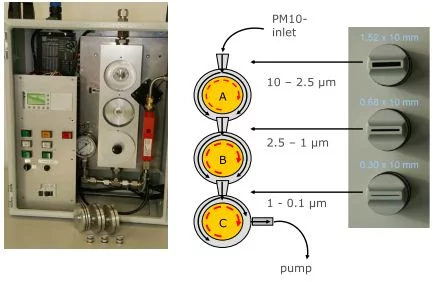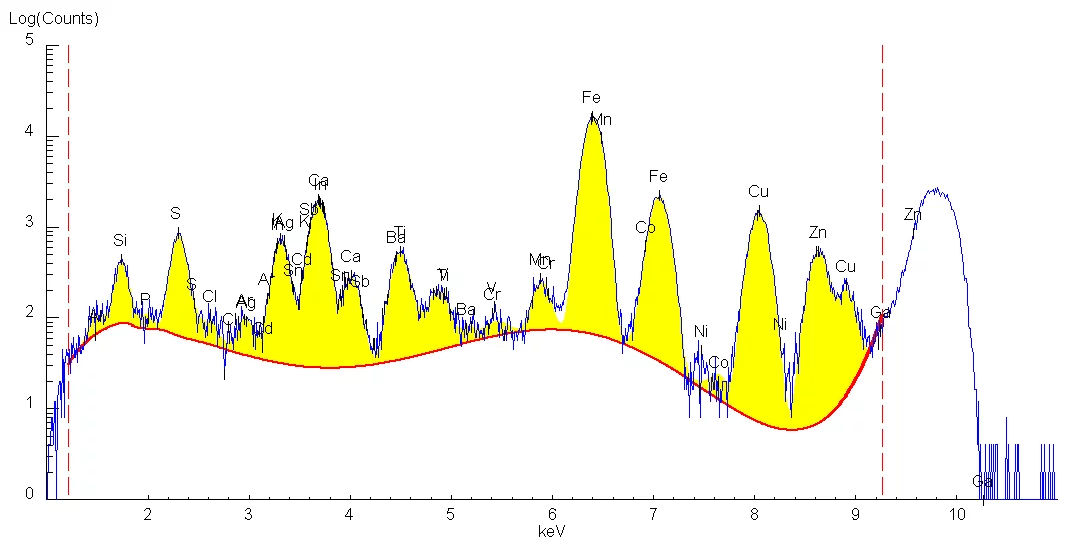Rotating Drum Impactor Sampling
Rotating drum impactors (RDI) of the Lundgren type have been used since the 1960s. Air is sucked through nozzles specifically designed such that a select size range of particles is impacted on a mylar or polypropylene tape, while the remaining particles are carried by the airflow to the next impaction stage. In this way, a series of particle size ranges can be collected. Our RDIs segregate particles into the three size ranges 10 - 2.5 micrometers, 2.5 - 1.0 micrometer, and 1.0 - 0.1 micrometer, representing the relevant size ranges for regulatory purposes and for the study of health effects. During sampling the impactor drums are kept fixed, then they are rotated to the next position for the next sample. This generates a barcode-like pattern of deposited material. The polypropylene tapes are greased with Apiezon-L to increase the collection efficiency for particles. Sampling times can be set in the order of 1 hour, which increases the time resolution substantially when compared to conventional 24-h filter sampling. Diurnal variations in trace element concentrations become measurable.Synchrotron Radiation-induced X-ray Fluorescence Spectrometry
X-rays are used for the excitation of elements in ambient samples and their detection via the element-characteristic fluorescence lines. After excitation of the sample elements, the emitted fluorescent radiation is measured with an energy-dispersive detector, and a spectrum of a wide range of elements present in the sample is obtained. Since the amount of sample material is limited, the high sensitivity and low detection limits achieved with the XRF method at synchrotron facilities is crucial for the detection of trace elements. In addition to the high sensitivity, the fact that no further sample preparation is needed is an important aspect of synchrotron radiation induced X-ray fluorescence spectrometry (SR-XRF). Our technique allows for the analysis of several thousands of individual samples in reasonable time, given the generally restricted amount of beamtime available at the synchrotron facilities. Measurements have been performed so far at the Swiss Light Source (SLS), at HASYLAB (Hamburg, Germany), and at the Advanced Light Source (ALS, Berkeley, USA).
Projects and field campaigns
- NF China-XRF (2016-2019) with measurements in Beijing (2017), New Delhi (2019), Krakow (2018, 2019)
- ClearfLo - Clean Air for London - United Kingdom (2012)
- XRF-PMF (2011-2013)
- RDI-SR-XRF (2008-2011)
- CalNex-LA, Pasadena, California, USA (2010)
- MEGAPOLI, Paris, France (2009, 2010)
- EUCAARI, Zürich, Switzerland, 2008-2009
- DAURE, Barcelona, Spain (2008)
- EMEP/EUCAARI, Payerne, Switzerland, (2008)
- FAME'08, Finokalia, Crete, Greece (2008)
- APART, Zürich and Reiden, Switzerland (2007-2008)
Publications
Theses
Analysis of major and trace elements in ambient aerosols and their sources in European and Asian cities.
Rai, P., 2020.
Diss. ETH No. 26608 Thesis, ETH Zürich, Villigen, Switzerland.
DOI:
Highly time- and size-resolved ambient trace element analysis and source apportionment.
Visser, S., 2015.
Diss. ETH No. 22520 Thesis, ETH Zürich, Villigen, Switzerland.
DOI: 10.3929/ethz-a-001987748
Determination of trace elements in ambient aerosols with synchrotron induced X-ray fluorescence spectrometry and subsequent source apportionment.
Richard, A. C. J., 2011.
Diss. ETH No. 19667 Thesis, ETH, Zürich, Switzerland, 160 pp.
DOI: 10.3929/ethz-a-006550233
Articles
-
Rai P, Furger M, Slowik JG, Canonaco F, Fröhlich R, Hüglin C, et al.
Source apportionment of highly time-resolved elements during a firework episode from a rural freeway site in Switzerland
Atmospheric Chemistry and Physics. 2020; 20(3): 1657-1674. https://doi.org/10.5194/acp-20-1657-2020
DORA PSI -
Rai P, Furger M, El Haddad I, Kumar V, Wang L, Singh A, et al.
Real-time measurement and source apportionment of elements in Delhi's atmosphere
Science of the Total Environment. 2020; 742: 140332 (16 pp.). https://doi.org/10.1016/j.scitotenv.2020.140332
DORA PSI -
Furger M, Rai P, Slowik JG, Cao J, Visser S, Baltensperger U, et al.
Automated alternating sampling of PM10 and PM2.5 with an online XRF spectrometer
Atmospheric Environment: X. 2020; 5: 100065 (6 pp.). https://doi.org/10.1016/j.aeaoa.2020.100065
DORA PSI -
Furger M, Minguillón MC, Yadav V, Slowik JG, Hüglin C, Fröhlich R, et al.
Elemental composition of ambient aerosols measured with high temporal resolution using an online XRF spectrometer
Atmospheric Measurement Techniques. 2017; 10(6): 2061-2076. https://doi.org/10.5194/amt-10-2061-2017
DORA PSI -
Visser S, Slowik JG, Furger M, Zotter P, Bukowiecki N, Dressler R, et al.
Kerb and urban increment of highly time-resolved trace elements in PMsub>10, PM2.5 and PM1.0 winter aerosol in London during ClearfLo 2012
Atmospheric Chemistry and Physics. 2015; 15(5): 2367-2386. https://doi.org/10.5194/acp-15-2367-2015
DORA PSI -
Visser S, Slowik JG, Furger M, Zotter P, Bukowiecki N, Canonaco F, et al.
Advanced source apportionment of size-resolved trace elements at multiple sites in London during winter
Atmospheric Chemistry and Physics. 2015; 15(19): 11291-11309. https://doi.org/10.5194/acp-15-11291-2015
DORA PSI -
Richard A, Bukowiecki N, Lienemann P, Furger M, Fierz M, Minguillón MC, et al.
Quantitative sampling and analysis of trace elements in atmospheric aerosols: impactor characterization and synchrotron-XRF mass calibration
Atmospheric Measurement Techniques. 2010; 3(5): 1473-1485. https://doi.org/10.5194/amt-3-1473-2010
DORA PSI -
Richard A, Gianini MFD, Mohr C, Furger M, Bukowiecki N, Minguillón MC, et al.
Source apportionment of size and time resolved trace elements and organic aerosols from an urban courtyard site in Switzerland
Atmospheric Chemistry and Physics. 2011; 11(17): 8945-8963. https://doi.org/10.5194/acp-11-8945-2011
DORA PSI -
Bukowiecki N, Richard A, Furger M, Weingartner E, Aguirre M, Huthwelker T, et al.
Deposition uniformity and particle size distribution of ambient aerosol collected with a rotating drum impactor
Aerosol Science and Technology. 2009; 43(9): 891-901. https://doi.org/10.1080/02786820903002431
DORA PSI -
Bukowiecki N, Lienemann P, Zwicky CN, Furger M, Richard A, Falkenberg G, et al.
X-ray fluorescence spectrometry for high throughput analysis of atmospheric aerosol samples: the benefits of synchrotron X-rays
Spectrochimica Acta B: Atomic Spectroscopy. 2008; 63(9): 929-938. https://doi.org/10.1016/j.sab.2008.05.006
DORA PSI -
Bukowiecki N, Hill M, Gehrig R, Zwicky CN, Lienemann P, Hegedüs F, et al.
Trace metals in ambient air: hourly size-segregated mass concentrations determined by synchrotron-XRF
Environmental Science and Technology. 2005; 39(15): 5754-5762. https://doi.org/10.1021/es048089m
DORA PSI



